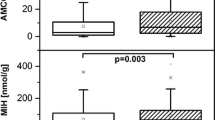Summary
Liver injury has long been associated with occupational exposure to a wide variety of chemicals. The controversial data existing in relation to hepatotoxicity of organic solvents might be explained as a consequence of the different exposures or it may well be that the tests used for evaluating liver function might not be sensitive enough to detect any mild changes at an early stage. To study liver function during exposure to solvent mixtures, we determined serum bile acid (SBA) concentrations as compared with conventional liver function tests in a selected group of workers (n = 30) occupationally exposed to a mixture of organic solvents (mostly toluene, xylene, acetone, n-butylacetate, n-butanol, ethylacetate) and in a reference group (n = 20). The mean levels of liver enzyme activities and bilirubin concentrations in the two groups were similar, whereas mean SBA levels increased in the exposed group (8.0 ± 6.0 μmol/l vs 2.8 ± 1.4 μmol/l) and the difference as compared with the controls was significant (P < 0.01). In 73% of the exposed workers, SBA levels were higher than 5.6 μmol/l (the cut-off value) as compared with 5% of the controls. These results demonstrate the higher sensitivity in detecting liver dysfunction achieved with the SBA test as compared with conventional hepatic function tests. As increased SBA concentrations are considered to reflect an impairment of anion transport across the liver, higher SBA levels in the group of workers exposed to organic solvents might be explained as a slight and early sign of liver dysfunction. Therefore, SBA determination in biological monitoring of workers exposed to potentially hepatotoxic chemicals might be proposed.
Similar content being viewed by others
References
ACGIH (1984) TLVs Threshold Limit Values for chemical substances in the work environment adopted by ACGIH for I984-85. Cincinnati
Axelson O, Gustavson J (1978) Some hygienic and clinical observations on styrene exposure. Scand J Work Environ Health [Suppl 4] 2:215–219
Barnes S, Gallo GA, Trash DB, Morris JS (1975) Diagnostic value of serum bile acid estimations in liver disease. J Clin Pathol 28:506–509
Davidson CS, Leevy CM, Chamberlayne EC (1979) Guidelines for detection of hepatotoxicity due to drug and chemicals. US Department of Health, Education and Welfare. NIH Publication 79–313
Døssing M, Bælum J, Lundqvist GR (1983) Antipyrine clearance during experimental and occupational exposure to toluene. Br J Ind Med 40:466–499
Døssing M, Skinhøj P (1985) Occupational liver injury. Present state of knowledge and future perspective. Int Arch Occup Environ Health 56:1–21
Douglas JG, Beckett GJ, Nimmo IA, Finlayson NDC, Percy-Robb IW (1981) Clinical value of bile salt tests in anicteric liver disease. Gut 22:141–148
Editorial (1982) Serum bile acids in hepatobiliary disease. Lancet 2:1136–1138
Edling C, Tagesson C (1984) Raised serum bile acid concentrations after occupational exposure to styrene: a possible sign of hepatotoxicity? Br J Ind Med 41:257–259
Elofsson SA, Gamberale F, Hindmarch T, Iregren A, Isaksson A, Johansson I, Knave D, Lydahl E, Mindus P, Persson HE, Philipson B, Steby M, Struwe G, Søderman E, Wennberg A, Widen L (1980) Exposure to organic solvents. Scand J Work Environ Health 6:239–273
Fishbein A, Ross RR, Lerman Y (1983) Industrial solvents and the liver. Lancet 1:129
Hane M, Axelson O, Blume J, Hogsted C, Sundell L, Yderborg B (1977) Psychological function changes among house painters. Scand J Work Environ Health 3:91–99
Härkonen H, Lehtuiemi A, Aitio A (1984) Styrene exposure and the liver. Scand J Work Environ Health 10:59–61
Hotz P, Guillemin MP, Lob M (1980) Study of some hepatic effects (induction and toxicity) caused by occupational exposure to styrene in the polyester industry. Scand J Work Environ Health 6:206–215
Kaplowitz N, Kok E, Javitt NB (1973) Postprandial serum bile acid for the detection of hepatobiliary disease. JAMA 225:292–293
Kurppa K, Husman K (1982) Car painters exposure to a mixture of organic solvents. Serum activities of liver enzymes. Scand J Work Environ Health 8:137–140
Kurppa K, Tola S, Hernberg S, Tolonen M (1983) Industrial solvents and the liver. Lancet 1:129
Liss GM, Greenberg RA, Tamburro CH (1985) Use of serum bile acids in the identification of vinyl chloride hepatotoxicity. Am J Med 78:68–75
Lundberg I, Hakansson M (1985) Normal serum activities of liver enzymes in Swedish paint industry workers with heavy exposure to organic solvents. Br J Ind Med 42:596–600
Popper H, Gerber MA, Schaffner F, Selikoff IJ (1979) Environmental hepatic injury in man. In: Popper H, Schaffner F (eds) Progress in liver disease. Grune and Stratton, New York San Francisco London, pp 605–638
Schuttmann W, Ullmann W (1973) Die Leberwirksamkeit von Nitrolackverdünnern. Z Ges Hyg Ihre Grenzgeb 19:189–193
Sotaniemi EA, Sutinen Se, Sutinen Si, Arranto AJ, Pelkonen RO (1982) Liver injury in subjects occupationally exposed to chemicals in low doses. Acta Med Scand 212:207–215
Szadkowski D, Pfeiffer D, Angerer J (1976) Beurteilung einer beruflichen Toluolexposition hinsichtlich ihrer hepatotoxischen Relevanz. Med Wochenschr 30:25–28
Tamburro CH (1979) Chemical hepatitis, pathogenesis, detection and management. Med Clin North Am 63:545–566
Tamburro CH, Greenberg RA (1981) Effectiveness of federally required medical laboratory screening in the detection of chemical liver injury. Environ Health Persp 41:117–122
Tobiasson P, Bocryd B (1980) Serum cholic and chenodeoxycholic acid conjugates and standard liver function tests in various morphological stages of alcoholic liver disease. Scand J Gastroenterol 15:657–663
Waldron HA, Cherry N, Venables H (1982) Solvent exposure and liver function. Lancet 2:1276
Author information
Authors and Affiliations
Rights and permissions
About this article
Cite this article
Franco, G., Fonte, R., Tempini, G. et al. Serum bile acid concentrations as a liver function test in workers occupationally exposed to organic solvents. Int Arch Occup Environ Health 58, 157–164 (1986). https://doi.org/10.1007/BF00380767
Received:
Accepted:
Issue Date:
DOI: https://doi.org/10.1007/BF00380767




